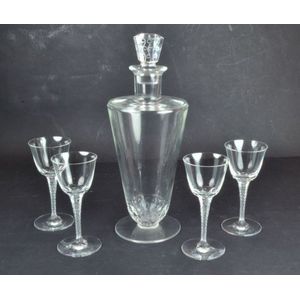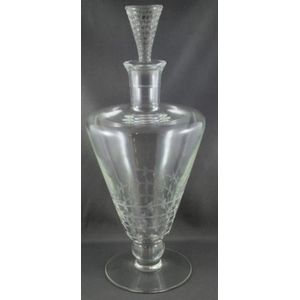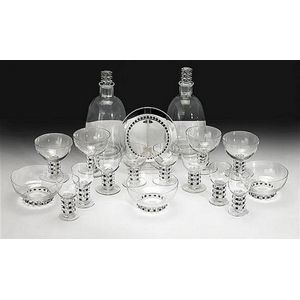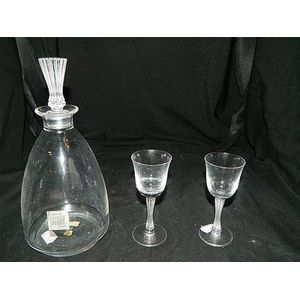
Lalique Frosted Ribbed Decanter with Clear Stopper
Lalique: a 'Langeais' decanter, the spherical body with frosted ribs, clear stopper and neck, engraved signature to base: Lalique R France, height 25 cm

Lalique Saint Hubert Crystal Decanter (24cm)
Lalique France 'Saint Hubert' crystal decanter, etched signature to base, height 24 cm

Lalique 'Barsac' Crystal Decanter (25.5cm)
Lalique France 'Barsac' crystal decanter etched to base, height 25.5 cm

Lalique Crystal Decanter & Six Glasses, Femmes Antiques Pattern
Good Lalique crystal decanter & six glasses 'Femmes Antiques,' pattern, heights 25 cm, decanter; and 10 cm, glasses, each. All with inscribed mark to base.

Lalique Crystal Highlands Decanter with Pierced Stopper
Lalique 'Highlands' crystal decanter, of rounded form with a pinched base, with pierced stopper, signed, height 26.5 cm

Art Deco Lalique Glass Decanter with Silver Collar
Lalique Art Deco glass decanter, French, circa 1930s, later applied silver collar, engraved 'R. Lalique', 276 cm high

Art Deco Blue Glass Lalique Decanter 'Dundee' c1927
Rare Lalique Art Deco blue glass decanter 'Dundee' design c1927

Lalique Frosted Glass Drinks Set
Lalique drinks suite with a tapering frosted glass, decanter and four shot glasses. Signed Lalique France to base, height 25 cm

Lalique Fontainbleau Crystal Decanter with Stopper
A Lalique, France, Fontainbleau crystal decanter with decorative stopper, c.1996-2000, etched to base, height 26 cm

Lalique Crystal Decanter with Facetted Stopper
Lalique crystal decanter, of facetted form with concave sides and geometric cut borders, with facetted stopper, a/f, marked Lalique France to base, height 26 cm

Lalique Antiques Crystal Decanter with Frosted Maidens Frieze
Lalique Femmes Antiques crystal decanter, designed by Marc Lalique, of elliptical form, decorated with a frosted frieze of classical maidens, with spiraled spherical stopper and facetted base, marked Lalique France to base, height 24 cm

Lalique France Decanter and Glasses Set
A Lalique France decanter and four glasses, second half 20th century, engraved signatures to bases, heights 24.7 cm & 12.5 cm

Lalique France Decanter and Four Glasses Set
A Lalique France conical shape decanter & four glasses engraved signature to bases decanter, height 29.5 cm, glasses: height 13.5 cm

Lalique Crystal Decanter, Mid 20th Century
A Lalique France Langeais crystal decanter mid 20th century engraved Lalique France to base, height 24.8 cm

Rene Lalique Satyre Decanter for Cusenier
A Rene Lalique 'Satyre' decanter for Cusenier, with satyr moulded handle with reddish brown patination to the handle and stopper, chip to rim, remnants of original Cusenier label. Signed c.1923. Height 24.5 cm

Lalique Clear Crystal Langeais Decanter
Lalique 'Langeais' decanter clear crystal of both fluted antique columns and modernist architecture, it takes seven glass masters to create this decanter using the time-honored techniques of souffle tourne (turned while blown) and presse aspire souffle…

Lalique Crystal Decanter with Stopper
Lalique crystal decanter, inscribed to base. With stopper. Height 30 cm.

Lalique Langeais Crystal Decanter
Lalique crystal 'Langeais' decanter the exaggerated, bulbous satin-finished stem of Langeais is in direct contrast with the smooth silhouette of the clear crystal bowl. the finely striated bulb of the stem features both satin-finished & clear crystal in…

Lalique 'Langeais' Crystal Decanter, 25.5cm Height
A Lalique 'Langeais' crystal decanter, satin finished crystal, signed Lalique France. Height 25.5 cm

Lalique Crystal Decanter with Frosted Bands and Beads
Lalique crystal 'Champs De Mars' decanter having applied wavy frosted bands, & with beaded detail. Stamped to the base. Height 25 cm

Lalique Crystal Decanter, Signed, 25 cm High
Lalique crystal decanter, signed 'Lalique France' to base, 25 cm high approx.

Rene Lalique Sainte-Odile Decanter
Rene Lalique, Sainte?Odile' Decanter, designed 1927, clear and frosted glass, moulded to the underside 'R. Lalique Clos Ste Odile Obernai Pierre Weissenburger, height 23 cm, Labels: Decanter created for the wine merchant Pierre Weissenburger, Alsace,…

Lalique 'Femmes Antiques' Decanter & Tumbler Set (7 pcs)
A Lalique France 'Femmes Antiques' decanter & tumbler set, comprising decanter and six tumblers, (7)

Lalique 'Barsac' Stemware and Decanter Set
A large suite of Lalique 'Barsac' stemware and decanter, comprising, 11 x flutes, 11 x red, 7 x white, 4 x port, 6 x liqueur glasses

Lalique Barsac Decanter, Clear and Frosted Glass
Lalique, Barsac' decanter, model no. 15051, clear and frosted glass, etched signature 'Lalique France' to underside, height 25.5 cm

Rene Lalique Glass Drinking Set (1926)
Rene Lalique Unawihr glass drinking set, designed c. 1926 including two decanters, six dessert plates, four dessert bowls, six champagne glasses, six liqueur glasses, five white wine glasses and two red wine glasses, two glasses and the two stoppers are…

Lalique 'Raisins' Decanter with Grapes and Vines Decoration
A Lalique 'Raisins' decanter and stopper, circa 1930 the elliptical decanter having moulded decoration depicting grapes amongst vines, clear glass with grey wash, moulded 'R.Lalique' to base 27 cm high inclusive of stopper. Other Notes: Reference :…

Lalique Feather Decanter with Signature and Sticker
Lalique decanter with a feather design stopper, with etched signature to the base and original 'Cristal Lalique Paris' sticker. Condition good, some minor age related wear. Height 26 cm

Lalique 'Langeais' Drink Suite with Champagne Flutes
Lalique 'Langeais' drink suite comprising a decanter, pitcher and six champagne flutes, with a bulbous body and satin-finished and clear crystal in alternating grooves. The jug with original paper label, both with 'Made in France' stickers to the base and…

Lalique Crystal Decanter - Signed and Stunning
Lalique crystal decanter signed 'Lalique France' to base, 25.5 cm high approx

Lalique Valencay Decanter - 28.25 cm
Lalique Valencay pattern decanter, approximately 28.25 cm. As inspected

Lalique Valencay Decanter - Engraved Mark, 28.25 cm Tall
Lalique Valencay decanter, Approximately 28.25 cm tall. Engraved mark to base

Lalique France Art Deco Conical Decanter (8 words)
Art Deco Lalique decanter, of conical form, marked Lalique France to base, 32 cm high approx

Lalique Liqueur Set with Decanter and Glasses
Lalique liqueur set consisting of a Lalique barsac decanter, seven red wines, three wine wines, three champagne bowls, four dessert wines, eleven brandy glasses and twelve sherry glasses. Height of decanter 25 cm

Lalique Crystal Parme Decanters, Signed
Lalique crystal pair of 'Parme' decanters signed 'Lalique France' to base. Height 27.5 cm

Art Deco Lalique Glassware Set
A selection of Art Deco Lalique 'Unawihr' glassware, circa 1926 the clear glass with cube appliques highlighted in black enamel comprising: six large wine glasses, two slightly smaller wine glasses, five medium wine glasses, six small wine glasses, four…

Lalique Glass Vase with Figurines Relief Decoration
A Lalique Douze figurines glass vase, circa 1921 of decanter form, the frosted glass sides decorated with six pairs of women in relief, rising to a short narrow neck. Model 913, signed to base R.Lalique 22 cm high. Literature: Fleix Marcilhac, R.Lalique,…

Lalique Grape Decanter with Stopper
Lalique Clos Vougeot decanter and stopper, of bulbous from with moulded grapes, with a stopper with moulded grapes. 30 cm high.

Lalique 'Langeais' Drinks Suite
Lalique 'Langeais' drinks suite consisting of decanter, jug, eleven champagne flutes, thirteen white wine glasses and eleven red wine glasses. Height of tallest 25 cm

Lalique St Hubert Drinks Suite
Lalique 'St Hubert' drinks suite consisting of a decanter and twelve glasses. Height of decanter 24 cm

Lalique Glass Decanter with Flower Stopper
Lalique decanter glass decanter with glass flower stopper, etched to base 'Lalique France'. Height 23 cm







 Loading more...
Loading more...